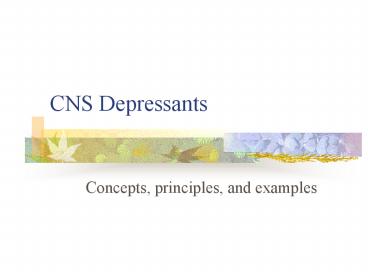CNS Depressants - PowerPoint PPT Presentation
1 / 12
Title:
CNS Depressants
Description:
CNS Depressants Concepts, principles, and examples Terms and concepts Depressant, sedative, tranquillizer, anxiolytic, hypnotic Levels of sedation: Conscious levels ... – PowerPoint PPT presentation
Number of Views:165
Avg rating:3.0/5.0
Title: CNS Depressants
1
CNS Depressants
- Concepts, principles, and examples
2
Terms and concepts
- Depressant, sedative, tranquillizer, anxiolytic,
hypnotic - Levels of sedation
- Conscious levels Anxiolytic, behavioral
disinhibition, sedation - Unconscious levels Hypnagogic state, sleep,
anaesthesia, coma.
3
Juliens principles of CNS depressants
- CNS depressants are additive with each other and
with the behavioral state of the user.
Supradditive synergistic. - CNS depressants are antagonists of the behavioral
stimulants, but in a non-specific fashion. - Rebound or withdrawal is unlikely after a single
dose of a CNS depressant. - Dependence, psychological dependence, and
tolerance do occur to CNS depressants.
4
Mechanisms of action
- Reversible depression of excitable tissue
barbiturates and non-barbiturates, ethyl alcohol,
and general anaesthetics. - Greater depression of polysynaptic pathways, such
as the reticular activating system (RAS). - Potentiating the GABAA receptor complex
barbiturates prolong Cl- access 4 to 5 times.
5
The mental status exam
- 1. General appearance
- 2. Sensorium
- a. Orientation
- b. Clarity/cloudiness
- 3. Behavior/manner
- 4. Stream of talk
- 5. Cooperativeness
- 6. Mood (Feeling)
- 7. Affect (expression)
- 8. Perception
- a. Illusions
- b. Hallucinations
- 9. Logical thought?
- 10. Knowledge
- 11. Intellect function
- 12. Insight/judgment
6
General CNS depressants
- Barbiturates A family of over 2500 derivatives
of barbituric acid, of which about 50 have been
marketed. First used in 1912 (phenobarbital). - Nonbarbiturate hypnotics Early 1950s
- Tranquillizers
- General anaesthetics
- Abused inhalants
7
The barbiturates
- Pharmacological phenomena
- Pharmacokinetics
- Ultra-short acting Short (re)distribution
half-lives - Short- to long-acting Long elimination
half-lives - Low selectivity and low TI
- Sleep abnormalities
- REM suppression
- REM rebound and rescidivism
8
Barbiturates, continued
- Psychopharmacological phenomena
- Repeated use leads to tolerance and dependence
- Individual reactions may be be different from
sedation depression, agitation, and aggressive
behavior may occur, influenced by - mental set
- social setting
- pain
- Affects movement and judgment like alcohol
9
Nonbarbiturate hypnotics
- Glutethimide (Doriden), ethchlorvynol (Placidyl),
and methyprylon (Noludar) in early 1950s - The methaqualone (Quaalude) episode
- 1951 Malaria treatment
- 1965 Tranquillizer and panacea
- 1972-73 Abuse epidemic
- 1973 Placed on Schedule II
- 1984 Withdrawn from market by manufacturer
10
Antianxiety agents
- Dicarbamate derivatives
- Meprobamate (Equanil, Miltown)
- Mebutamate (Capla), tybamate (Solacen)
- Carisoprodol (Rela, Soma)
- Benzodiazepines
11
General anaesthetics
- Membrane fluidization and ion channel
perturbation - Gas Nitrous oxide
- Volatile liquids
- Ether
- Halothane
- -fluranes ( iso-, des-, en-, and sevo-)
- Injectable GABA agonists
- Barbiturates, propofol (Diprovan), etomidate
12
The GABAA Receptor Complex
Cl-
Cl-
Cl-
Cl-
Cl-
Inside
Cl- ion channel
B A R B
B A R B
G A B A
G A B A
Cl-
E t O H
B D Z
Cl-
Cl-
Cl-
Cl-
Cl-
Outside































